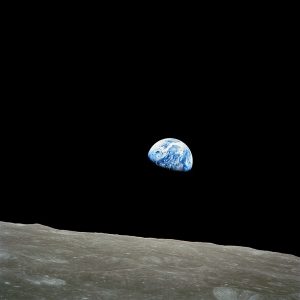A Tera-Scale Planet
A trillion. 1,000,000,000,000. A million millions. It’s a number that seems so far outside the scope of our everyday lives, but which, in many senses, is the defining scale of the Earth today. The prefix for a trillion is tera, curiously close to the Latin root word for Earth, terra. Because a trillion is used so much in this book to describe our terrestrial home, it’s worth describing a trillion in a few settings on Earth.
| hecto- | h | 100 | hundred |
| kilo- | k | 1,000 | thousand |
| mega- | M | 1,000,000 | million |
| giga- | G | 1,000,000,000 | billion |
| tera- | T | 1,000,000,000,000 | trillion |
Trillions
The world population is now closer to 10 billion than 5 billion. Imagine something that everyone on Earth has a little more than 100 of. Could be memories, or meals, or favorite songs. In many ways, lists of 100 would be a wonderful window into the lives of the citizens of the world. 125 memories per person on Earth. That’s a trillion memories, or a teramemory.
The top four richest people in the world have a combined wealth of over a trillion dollars. The world’s poorest 50% of people combined own less than just a few dozen individuals. Wealth inequality is increasing substantially, and it might not be long before trillionaires exist.
The U.S. government now routinely creates economic stimulus packages on the order of a trillion dollars, both for the financial crisis in 2008 and the COVID-19 pandemic in 2020 and 2021. A trillion dollars is $3000 for every American.
In the climate space, industrial activity has led to over 2.2 trillion metric tons of carbon dioxide to be released into the atmosphere. The first trillion took centuries. The most recent trillion took less than 30 years.
Over a trillion tons of carbon dioxide has accumulated in the atmosphere. The rest has gone into the ocean, where it has contributed to ocean acidification, or into the land.
Electricity generation in 1985 was a little over a 1 trillion watts (TW). The world exceeded 2 TW in 2004, and world electricity generation is now around 3.4 TW. That’s about 420 W per person, although the usage is very unequally distributed across the world.
Can a tera-scale planet Earth be sustainable? Yes. There is enough power to feed and provide basic needs even for a population much larger than today’s, with everyone having a high standard of living. It is not, however, sustainable to support an economic system that requires continuous growth.
Sunlight is abundant

The land surface of the Earth receives 26,800 TW of solar radiation. About 6,200 TW are reflected back to space, much of which makes it all the way back to space, as can be seen in the famous Earthrise image taken from a spacecraft orbiting the moon. A total of 20,600 TW are absorbed on Earth’s land surface.
The electricity generation on Earth is 3.4 TW. So we only need to utilize 0.02% of the Sun’s rays to power the world. This could be achieved with solar panels with area of the Philippines, or the state of Arizona. Sunlight is abundant. There is no need to dig up million-year-old fossil fuels as an energy source.
Connect
Climate Action Families is a group of families in Washington state dedicated to climate justice. They participate in the youth-led Plant for the Planet initiative aiming to plant one trillion trees.
- Check out and follow Zero Hour, an initiative co-founded by former youth Climate Action Families participant Jamie Margolin.
- Read Jamie’s book Youth to Power and watch her TEDx talk, “Patriarchy, Racism and Colonialism Caused the Climate Crisis.”

